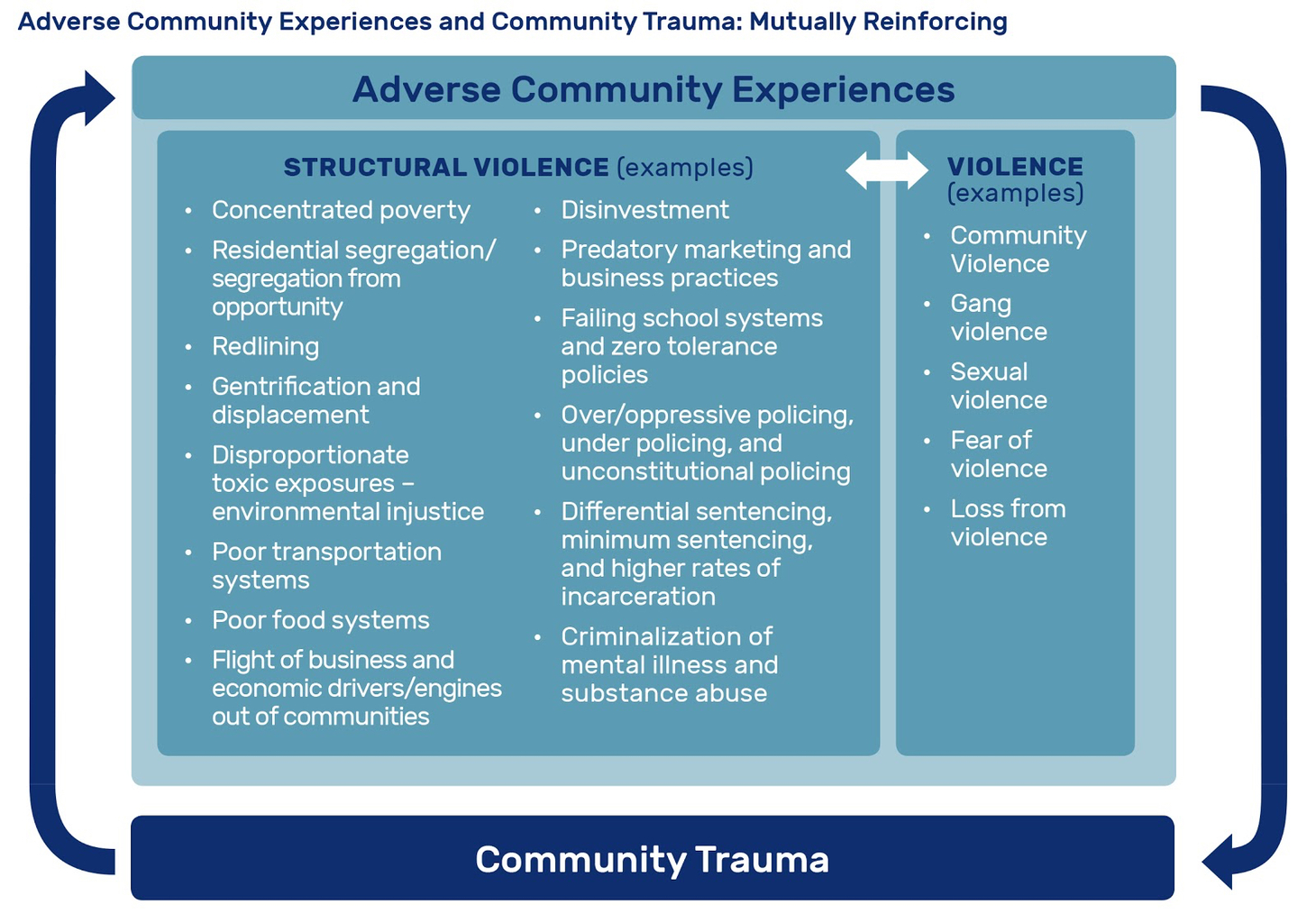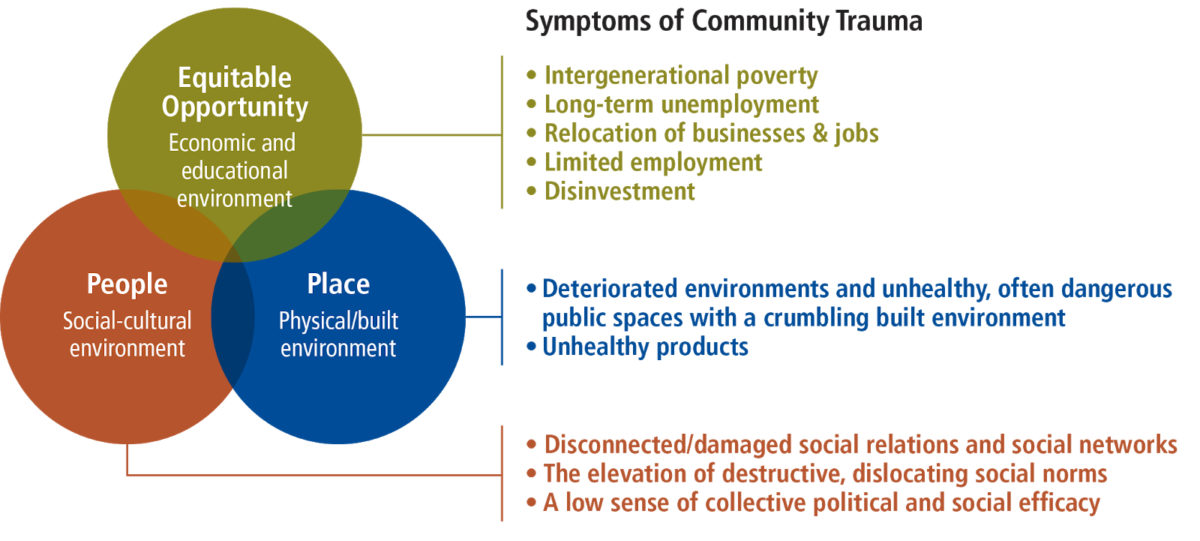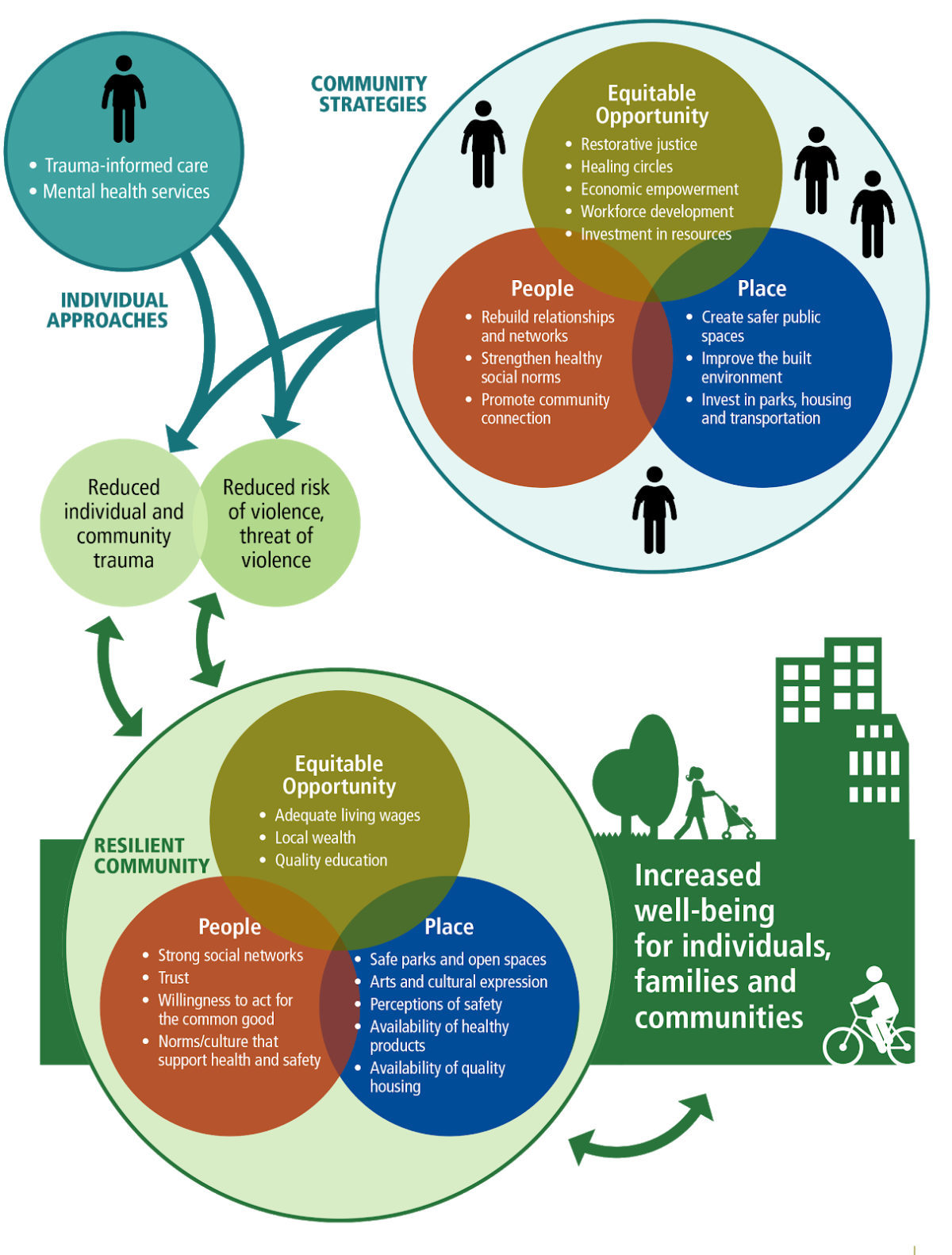Adverse Community Experiences and Resilience Framework
 Prevention Institute’s Adverse Community Experiences and Resilience Framework describes the experiences, conditions, and symptoms of trauma that adversely impact communities, neighborhoods, and schools, and proposes strategies for building more resilient communities
Prevention Institute’s Adverse Community Experiences and Resilience Framework describes the experiences, conditions, and symptoms of trauma that adversely impact communities, neighborhoods, and schools, and proposes strategies for building more resilient communities
The Adverse Community Experiences and Resilience Framework was developed by Prevention Institute, a national nonprofit dedicated to improving community health, safety, and well-being. The framework is described in the 2014 publication Adverse Community Experiences and Resilience: A Framework for Addressing and Preventing Community Trauma, written by Howard Pinderhughes, Rachel Davis, and Myesha Williams.
Prevention Institute has since published a useful and informative follow-up guide, What? Why? How? Answers to Frequently Asked Questions About the Adverse Community Experiences and Resilience Framework, and several profiles of organizations, networks, and communities throughout the United States have used and adapted the model to address and prevent community trauma, which are summarized in the report Adverse Community Experiences and Resilience: Learning from Practice.
“Trauma and its associated symptoms of mental and psychological illness are more prevalent in the U.S. than in most other countries in the world. What’s more, trauma can be a barrier to the most successful implementation of healing and well-being strategies, including those to prevent violence. The impact of trauma extends beyond the individuals who directly witness or experience violence. Trauma is also produced by structural violence, which prevents people and communities from meeting their basic needs. The result is both high levels of trauma across the population and a breakdown of social networks, social relationships, and positive social norms across the community—all of which could otherwise be protective against violence and other health outcomes. While new models are emerging to counter the effects of trauma, promote community healing, and foster community resilience, there has not been an existing framework for understanding, addressing, and preventing trauma at a community or population level. Our paper provides one.”
Adverse Community Experiences and Resilience: A Framework for Addressing and Preventing Community Trauma
While the Adverse Community Experiences and Resilience Framework was developed primarily for use in the public health sector, the conditions and symptoms it describes also adversely impact the functioning of school communities and the education of children, and many of the proposed strategies have direct application in education organizing, engagement, and equity work.
In the introduction to Adverse Community Experiences and Resilience, the authors explain why the framework was created:
“To address widespread trauma at this scale means not only providing trauma-informed care for affected individuals, but also addressing trauma at the population level, as with any epidemic. As mental health expert Dr. George Albee stated, ‘No epidemic has ever been resolved by paying attention to the treatment of the affected individual.’ A focus solely on the treatment of individuals can only be part of a comprehensive solution…. The impact of trauma extends beyond the individuals who directly witness or experience violence. Vicarious trauma impacts, for example, service providers, first responders, and residents in high-violence communities. The result is both high levels of trauma across the population and a break-down of social networks, social relationships, and positive social norms across the community—all of which could otherwise be protective against violence. While new models are emerging to counter the effects of trauma, promote community healing and foster community resilience, there has not been an existing framework for understanding, addressing, and preventing trauma at a community or population level.”
Adverse Community Experiences and Resilience Framework
Adverse Community Experiences and Resilience: A Framework for Addressing and Preventing Community Trauma describes how trauma manifests and can be addressed at three levels of the community environment:
- Social-Cultural Environment (People)
- Physical/Built Environment (Place)
- Economic Environment (Equitable Opportunity)
The authors outline a three-stage framework for understanding and reducing trauma at each level of the community environment:
- Conditions that produce community trauma and the symptoms that result.
- Strategies that help communities respond to and address trauma.
- Elements of community resilience that support healing and alleviate trauma-inducing conditions.
Themes and Findings on Community Trauma
According to the authors, the Adverse Community Experiences and Resilience Framework “was developed based on a literature review, interviews with practitioners in high-violence communities in Northern California, and interviews and ongoing communication with members of the UNITY City Network.” Urban Networks to Increase Thriving Youth (UNITY) is a national initiative that builds support for effective and sustainable violence-prevention programs in cities throughout the United States. More than 20 cities are part of Prevention Institute’s UNITY City Network.
“Community trauma is the product of the cumulative and synergistic impact of regular incidents of interpersonal, historical, and intergenerational violence and the continual exposure to structural violence. Structural violence refers to harm that individuals, families, and communities experience from the economic and social structure, social institutions, social relations of power, privilege and inequality and inequity that may harm people and communities by preventing them from meeting their basic needs. Structural violence is a primary cause of the concentration of premature death and unnecessary disability in oppressed communities and is very closely linked to social injustice. Just as individuals who are subject to trauma from exposures to violence require healing to promote wellness and resiliency, communities need to heal from the trauma of interpersonal, structural, historical and institutional violence.”
Adverse Community Experiences and Resilience: A Framework for Addressing and Preventing Community Trauma
The authors provide an overview of the principal themes and findings from their research:
A. There is a growing understanding that trauma is widespread and has far-reaching impacts. The predominant approach to dealing with trauma is screening and treatment, consistent with a medical model.
- Trauma—such as post-traumatic stress disorder (PTSD)—is pervasive, especially in economically disadvantaged urban areas where residents are at higher risk of being exposed to traumatic events such as violence, crime, substance abuse, malnutrition, neglect, or physical and emotional harm.
- Trauma has a significant impact on human development, health, and well-being, and children and youth who are exposed to chronic or recurring trauma can suffer from PTSD symptoms, cognitive and developmental impairments, and higher rates of anxiety, depression, and illness.
- Exposure to multiple forms of violence simultaneously and/or throughout one’s life—a condition called poly-victimization or complex trauma—is associated with a range of potentially debilitating symptoms, including anxiety, panic attacks, sleeplessness, irritability, aggression, mental illness, or the inability to concentrate, relax, or let one’s guard down.
- Trauma-informed practices are becoming a standard practice in the field of public healthcare.
- The predominant approach to addressing individual trauma is based on a medical model, which is focused on screening and treating individuals, often without acknowledging the social, community, and environmental factors that may be causing or worsening individual symptoms.
B. Trauma manifests at the community level. There are emerging practices to address trauma at the community level, but there is not yet a framework for addressing and preventing it.
- There is an emerging understanding that a concentration of trauma among individuals and families profoundly impacts social cohesion, health, welfare, and opportunity throughout entire communities.
- There has been a shift from understanding trauma solely at the individual level to understanding collective trauma at the community level, and researchers are increasingly studying structural forms of trauma and their social consequences.
- Despite this increasing understanding of the widespread nature of trauma as a population-level epidemic, the predominant focus of trauma intervention remains at the individual level.
- Policymakers, public health officials, social-service providers, community organizers, and other practitioners report that trauma not only undermines their efforts to promote health, safety, and well-being in communities, but it also undermines the community’s ability to work together to develop solutions to community problems.
- Community trauma is not just the aggregate of individual trauma, but symptoms are observable in the social-cultural interactions, in the built environment (buildings or parks), and in the economic and educational opportunities in a community.
- Emerging practices, such as indigenous-based healing and restorative justice, are increasingly being used to address trauma at the community level.
- While many urban communities have people and organizations working to address trauma-related issues, levels of funding, knowledge, expertise, training, and other resources are uneven.
- Providers, advocates, researchers, and other practitioners do not have the conceptual foundation, language, or data they need to develop and implement strategies to reduce community trauma; therefore a framework for analyzing the symptoms of community trauma could inform a more comprehensive, coordinated, and effective approach.

Conditions and Symptoms of Community Trauma
The Adverse Community Experiences and Resilience Framework describes some of the major symptoms of trauma that manifest at each of the three levels of the community: People, Place, and Equitable Opportunity. According to the authors:
“In healthy communities, these three spheres can promote community health and safety and promote resiliency for individuals and families. When a community is traumatized, each of these spheres is undermined and damaged so they begin to perpetuate the problems rather than protect the community. That means that in traumatized communities, the community environment cannot promote resiliency. Instead, these factors can contribute to poor health, illness, and injury of community members through the exacerbation of trauma and by contributing to the production of interpersonal and community violence.”
1. Symptoms in the Social-Cultural Environment
- Damaged, fragmented, or disrupted social relations, particularly intergenerational relations, that can increase fear, distrust, and isolation within families, neighborhoods, schools, and communities.
- Damaged or broken social networks in trauma-inflicted communities, which can undermine the support systems that are the foundation for individual, family, and group resiliency.
- An escalation of harmful social norms, such as social tolerance for aggression, abuse, or violence, promotes violence and unhealthy behaviors rather than positive, community-building social norms.
- A decreased sense of collective social and political agency, such as a reluctance to intervene when others are in trouble or an unwillingness to participate in collective actions, programs, or campaigns that can strengthen the community.
2. Symptoms in the Physical/Built Environment
- Dilapidated, unhealthy, and often dangerous buildings, schools, parks, and other public spaces, and crumbling transportation infrastructure such as roads, bridges, sidewalks, and subways.
- Gentrification and rising housing and rental costs either displacing or increasing financial strain for poor and working-class families.
- The high availability and increased use of unhealthy products such as alcohol, drugs, or junk food.
3. Symptoms in the Economic Environment
- Multigenerational poverty and low educational attainment levels.
- Businesses relocating to other communities resulting in limited employment opportunities and long-term unemployment.
- Government and private disinvestment that reduces the financial resources available to schools, agencies, nonprofits, and other community support organizations.

Strategies for Addressing Community Trauma
1. Strategies for Addressing the Social-Cultural Environment
Strategies within the social-cultural environment counter the symptoms of community trauma and support healing and connection between people, while also shifting norms to support safe and healthy behaviors:
- Rebuild social relationships, particularly intergenerational relations.
- Revitalize damaged or broken social networks and infrastructure of social support.
- Strengthen and elevate social norms that promote or encourage healthy behaviors, community connection, and community-oriented positive social norms.
- Establish collaborations that promote community-level strategies while rebuilding community social networks.
- Change the narrative about the community and the people in it.
- Organize and promote regular positive community activity.
- Provide a voice and element of power for community folks around shifting and changing environmental factors as well as the structural factors.
- Promote and restore a connection to and sense of cultural identity, which has been shown to have a positive impact on mental health outcomes.
2. Strategies for Addressing the Physical/Built Environment
Strategies within the built environment focus on improving the physical environment, reducing deterioration, and creating space for positive interaction:
- Improve the quality of the built environment and public spaces and maintain these for the community.
- Create safer public spaces through improvements in the built environment by addressing parks, housing quality, and transportation.
- Reclaim and improve public spaces to make them more appealing to residents, reflective of community culture, and a source of pride that can contribute to a sense of community worth and support healing.
3. Strategies for Addressing the Economic Environment
Strategies within the economic environment increase educational access and quality, improve workforce training and readiness, and expand employment opportunities that pay a living wage:
- Institute restorative justice programs that shift conflict-resolution, school-discipline, and criminal-justice norms to support opportunities for reconciliation and restoration rather than punishment and incarceration.
- Support workforce-development strategies that improve the employment skills and readiness among community members, connect them to job opportunities that provide a living wage, and provide pathways to employment for formerly incarcerated individuals.
- Increase community wealth, resources, and economic prosperity to reduce dislocation and the adverse impact of gentrification.

Acknowledgments
Organizing Engagement thanks Andrea Buffa for her contributions to improving this introduction, and Prevention Institute for permission to republish images and excerpts from Adverse Community Experiences and Resilience: A Framework for Addressing and Preventing Community Trauma and What? Why? How? Answers to Frequently Asked Questions About the Adverse Community Experiences and Resilience Framework.
References
Pinderhughes, H., Davis, R., & Williams, M. (2015). Adverse Community Experiences and Resilience: A Framework for Addressing and Preventing Community Trauma. Oakland, CA: Prevention Institute.
Prevention Institute. (2018). Adverse Community Experiences and Resilience: Learning from Practice. Oakland, CA: Author.
Prevention Institute. (2017). Minimizing the Impact of Adverse Childhood Experiences through a Focus on Adverse Community Experiences. Oakland, CA: Author.
Prevention Institute. (2017). What? Why? How? Answers to Frequently Asked Questions about the Adverse Community Experiences and Resilience Framework. Oakland, CA: Author.
Creative Commons

This work by Organizing Engagement is licensed under a Creative Commons Attribution-NonCommercial-ShareAlike 4.0 International License. When excerpting, adapting, or republishing content from this resource, users should cite the source texts and confirm that all quotations and excerpts are accurately presented.